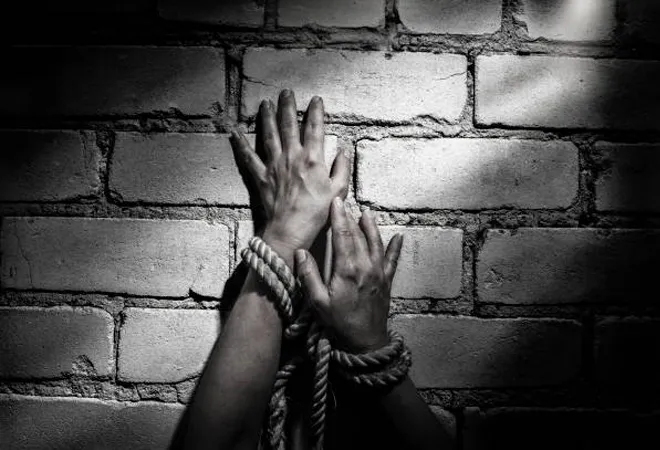-
CENTRES
Progammes & Centres
Location
Better border management and regulations need to be set in place by the BBIN member states to curb human trafficking in this region.

Since the past decade, human trafficking is becoming the fastest growing form of organised crime in the world. Reasons such as unemployment and poverty, political instability, and crime prevalence have pushed “the recruitment, transportation, transfer, harbouring or receipt of people through force, fraud or deception”. Such push factors that create a nexus of susceptible individuals go hand in hand with the pull factors—the wealthier markets where demand for low-waged labourers is high along with sexual exploitation of women and children. In this regard, poor management of international borders is frequently denoted as one of the primary reason for cross-border human trafficking, resulting in organised crimes, heightened corruption and also spread infectious diseases like HIV/AIDS. In fact, in the recent years, border management has increasingly been under scrutiny because of the low technical capacity of control agencies and border police, due to low funding and infrastructure. Thus, this leads to irregular follow ups and the victims of trafficking remain unidentified, especially in the unregulated or unorganised sectors. Even with the COVID-19 pandemic and border closures, the criminal networks are still thriving as the anti-social groups have been utilising more dangerous entry points, exposing the trafficked groups to higher risks of violence, abuse, and also diseases.
Poor management of international borders is frequently denoted as one of the primary reason for cross-border human trafficking, resulting in organised crimes, heightened corruption and also spread infectious diseases like HIV/AIDS.
Despite the much touted economic progress in South Asia, the region has been less resilient towards challenges regarding human security, social justice. inadequate governance, and weak criminal justice institutions. This region has been declared by the United Nations Office for Drugs and Crime as a very crucial “source, transit and destination” for large groups of people, including women and children, who have been victimised. In 2021, South Asia witnessed 150,000 cases of human trafficking. In this regard, the four important countries within this region—Bangladesh, Bhutan, India, and Nepal—have been attempting to address such social issues through an economic and connectivity framework. To understand this specific grouping is all the more important because India has been identified as a transit country for labour and sex trafficking. In fact, Bangladesh, Nepal, and Bhutan are three of the many source countries from where human trafficking is witnessed.
The open border between India and Nepal has made human trafficking far worse, with more than 30,000 Nepalese becoming victims to this. With the primary destination being either Africa or the Gulf region, transportation via train or bus to India is supposedly an easy route. The local border crossed in Nepal is Saunali border in the Maharajganj district of Uttar Pradesh (UP) and the Bairgania, Raxaul, and Narkatiaganj borders in Bihar. Primarily, the route leads to New Delhi, sometimes also via Mizoram, finally flying off to Dubai. Another route is through Kathmandu to New Delhi and then to Moscow, Spain, or South America.
The local border crossed in Nepal is Saunali border in the Maharajganj district of Uttar Pradesh (UP) and the Bairgania, Raxaul, and Narkatiaganj borders in Bihar.
Hundreds of impoverished rural Bangladeshi women are trafficked through the porous Indo-Bangladesh border by illicit criminal groups to countries such as India, Pakistan, and the Middle East. The estimated number is about 5 to 15 million—majorly young girls who are forced to work in Indian brothels. The Benopole border crossing is often regarded as the south-west transit point for transporting the victims from Jessore and Satkhira to Gojadanga and Hakimpur in Bangladesh. The border point here generally remains unmanned and unfenced making the process easier. The other districts of Bangladesh that have rampant trafficking are Kurigram, Lalmonnirhat, Nilphamari, Panchagarh, Thakurgaon, Dinajppur, Naogaon, Chapai Nawabganj, and Rajshahi.
Kokrajhar and Jalpaiguri are the main transit routes to traffick the victims from Bhutan to India and then to the destination countries. Even though not much documentation is available for the outmigration of young Bhutanese women by force or coercion, there are anecdotal reports of women and also increasing number of missing persons and commercial sex workers in and around the border towns.
The Benopole border crossing is often regarded as the south-west transit point for transporting the victims from Jessore and Satkhira to Gojadanga and Hakimpur in Bangladesh.
All these countries have been proactive in addressing the case of human trafficking that is directly threatening human security unilaterally, but after the concerted effort of the 11th SAARC Summit that brought about the issue of human trafficking by signing the SAARC Convention on Preventing and Combating Trafficking in Women and Children for Prostitution, not much work has been done at the cooperative level, all the more because the relevance of SAARC is at question. Nonetheless, the Asian Development Bank has been working on this front for many years now, specially addressing the impacts on vulnerabilities of high-risk groups. For example, the BBIN grouping as a whole has not been successful because it does not keep within the purview of consideration the impact of a motor vehicles agreement or better connectivity prospects for the local people, especially adolescent girls and children who are trafficked into cross border projects, subjected to exploitative conditions as a consequence of newer economic opportunities. Such investment projects are not only about trade and eradication of poverty but also the social ramifications that are associated with them. This section can be a part of the poverty alleviation programmes of the projects, making them more liable to be successful and agreeable for all to generate consensus for correct implementation. The government must include these policies in their institutional or multilateral frameworks to mainstream the operations. Only then will such bottlenecks not be looked upon as an issue to be solved bilaterally or by a single country in a region, but as an international issue.
The views expressed above belong to the author(s). ORF research and analyses now available on Telegram! Click here to access our curated content — blogs, longforms and interviews.

Sohini Nayak was a Junior Fellow at Observer Research Foundation. Presently she is working on Nepal-India and Bhutan-India bilateral relations along with sub regionalism and ...
Read More +